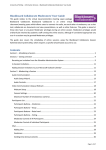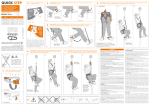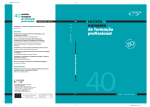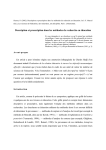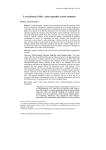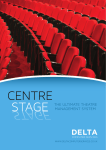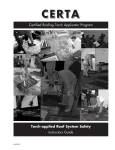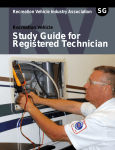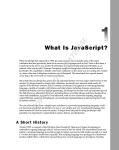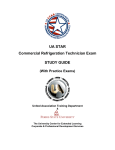Download THE RICHNESS OF OCCUPATIONAL INSTRUCTION
Transcript
THE RICHNESS OF OCCUPATIONAL INSTRUCTION:
THE PARADOX IN U.S. COMMUNITY COLLEGES
W. Norton Grubb
David Gardner Chair in Higher Education
The University of California, Berkeley
April 2001
Prepared for “Teaching and Learning within Vocational and Occupational Education
and Training”, Goettingen, Germany, Sept. 21 – 23, 2000; to be published as conference
proceedings.
ABSTRACT
Instruction in occupational subjects is potentially richer and more complex than
instruction in academic subjects. There are many competencies to master, including
manual and visual abilities, problem-solving and interpersonal skills as well as nonstandard linguistic and mathematical abilities. The settings of occupational education
are more complex because they include workshops (or real work), the location of
“hands-on” teaching with many different opportunities. And the divisions between
“skills” and “systems” approaches have important implications for the breadth of
learning, even though the distinctions are not widely recognized. But the special
pedagogical conditions of occupational education are routinely ignored, especially in
the English-speaking countries, and community colleges often fail to provide the
support necessary for their full development. The result is that the potential richness
and complexity of vocational instruction are often undeveloped within the classroom
and unrecognized by academic instructors and administrators.
2
THE RICHNESS OF OCCUPATIONAL INSTRUCTION:
THE PARADOX IN U.S. COMMUNITY COLLEGES*
W. Norton Grubb
David Gardner Chair in Higher Education
The University of California, Berkeley
Occupational education suffers from a central paradox. Instruction in
occupational subjects is potentially richer and more complex than instruction in
academic subjects. But the special pedagogical conditions of occupational education are
routinely ignored, especially in the English-speaking countries (Achtenhagen and
Grubb, 2001), and the educational institutions within which most occupational
instruction takes place often fail to provide the support necessary for its full
development. The result is that the potential richness and complexity of vocational
instruction are often undeveloped within the classroom and unrecognized by academic
instructors and administrators.
Within the U.S., occupational instruction takes place in a variety of settings.
However, within most high schools, vocational education has shrunk to include only a
business course or two, perhaps a few home economics courses, an occasional drafting
class — rather than complete programs of offerings. Short-term job training programs
also provide a great deal of vocational instruction, but these are typically within short
This paper draws upon Grubb and Associates(1999), especially Chapter 3, and on Achtenhagen and
Grubb (2001).
*
1
(e.g., fifteen week) courses preparing individuals for entry-level jobs, often using parttime instructors with little commitment to teaching. The institutions with the greatest
amount of relatively sophisticated occupational education, taught by permanent
faculty, are therefore community colleges.1 These colleges provide many different
programs including academic programs designed to allow students to transfer to the
university, occupational programs of great variety, and remedial education for those
who enter without the basic language and mathematical skills to do “college-level”
work. They cater to an enormous variety of students, of a great range of ages; while
many of them know precisely what they would like to accomplish, many others are
“experimenters” trying to decide what they might do with their lives, and using course
enrollment to find out. But virtually all students , even academic or transfer students,
are there for broadly occupational purposes, as many instructors note: "they're already
somebody but they want a decent job, you know — the American dream". In the end,
the responsibility of instructors is "to help students to get a job; that's what they're
coming here for". Overall about 60 percent of all students declare they are there for
occupational purposes, including an especially large fraction of part-time and older
students.
In addition, community colleges pride themselves on being “teaching
institutions”. While this phrase is often pure rhetoric, or implicitly acknowledges that
colleges are not research institutions like universities, it does reflect a widespread belief
among colleges that their comparative advantage in postsecondary education is the
2
creation of good teaching conditions, small classes, and instructors committed to
teaching.
For all these reasons, community colleges are ideal places to examine the
distinctive characteristics of occupational instruction. The results in this chapter are
based on observing and interviewing 114 occupational instructors in 23 community
colleges across the United States. (See Grubb and Associates, 1999, for more detail on
the methodology.) The most familiar subjects include business, computer and
information science (CIS) or information technology (IT), nursing and other health
occupations, early childhood education, electronics, drafting, various construction
trades, and automotive and diesel mechanics — all mainstays of community colleges.
But we also came across many unusual subjects: arborism; dairy herd management;
construction management; band instrument repair; electron microscopy. The programs
are as varied as the economy itself, and they change as the economy changes.
The complexity of occupational teaching comes from several different sources.
As I examine in Section I, in most occupations there are many competencies to master,
including manual and visual abilities, problem-solving and interpersonal skills as well
as conventional linguistic and mathematical abilities. While standard academic
competencies are also important, literacy practices are varied and sophisticated, and
quite different from those in academic classes; mathematics is also more applied, and
demanding more because it requires long sequences of applications rather than difficult
procedures. A second obvious difference, the subject of Section II, is that the settings of
occupational instruction are quite different from those for academic instruction:
3
Occupational instruction provides opportunities for both "doing" in a workshop and
"learning" in the classroom; the workshops or labs in most occupational programs, the
locus of "hands on" teaching, are unexpectedly sophisticated educational settings.
Sometime occupational program incorporate real work, creating yet another setting that
must be reconciled with classroom instruction.
A third dimension of complexity is that — just as English has had debates about
phonics versus whole language, or the “math wars” have debated conventional drilloriented approaches versus a more meaning- and problem-centered approach — so too
are there divisions within vocational teaching, between what I call “skills” approaches
on one hand and “systems” approaches on the other. Unfortunately there is little public
debate, or few associations or journals, or little research, to enable occupational
instructors to understand these differences, and so the approaches that different
instructors take are often idiosyncratic.
So the instructional tasks of occupational teachers are more demanding and
complex, though potentially richer for students, than are those of academic instructors.
But occupational instructors are often less able to find support on pedagogical issues;
the demands on their time are more taxing, and the funding requirements are much
more difficult, partly because of the ways most community colleges in the U.S. are
funded. The paradox, as I point out in Section IV, is that the most difficult and complex
form of instruction within community colleges often has the least institutional support.
4
I. The Competencies of Occupational Education
Conventional academic instruction focuses on the development and application
of symbolic systems — reading and writing, mathematics, and their applications in
conventional academic subjects in the humanities, sciences, and social sciences. In
contrast, most occupational classes involve many other competencies in addition to
verbal and mathematical abilities. Most of the time, they involve manipulative skills, or
(in the vocabulary of Gardner, 1983) kinesthetic intelligence: the ability to machine
parts, or use tools in construction and automotive trades, or to carry out medical
procedures in health occupations. Often visual ability is required, as in drafting classes,
in carpentry, in many other construction trades, and automotive classes where students
have to imagine how parts fit together in three dimensions. Auditory abilities (or
musical "intelligences") are more rare, though well-tuned cars sound a particular way,
and medical procedures often require recognizing the distinctive sounds of the heart
and respiratory system.
Instructors vary in the extent to which they make explicit the teaching of noncognitive abilities. In the traditional crafts and trades, instructors spend a good deal of
time showing hand skills and the proper use of tools; Culinary instructors will point out
the appropriate look and texture of food in different stages of preparation. Instructors in
areas involving three-dimensional construction will often spend time on the process of
visualization; as one automotive instructor said to his students, to get them to "read"
their texts (the "auto encyclopedia") in a different way:
5
If you buy an English 1A text, they may be complex and abstract but there are
only a few concepts. But the auto encyclopedia has vaster quantities of
information; it requires physics, engineering, et cetera. We have a heck of a
problem here trying to get you to visualize things, in your mind's eye . . . Your
visual skills are the most important skill you have.
And vocational instructors often spend considerable time teaching the distinctive
symbolic systems of their occupations, the ways in which work is described in
diagrams, maps, and specialized symbols.
However, in other cases instructors fail to teach non-cognitive abilities explicitly.
Many drafting instructors teach CAD as a series of computer commands necessary to
reproduce objects in three dimensions, ignoring the visual process of moving between
two and three dimensions. An employer complained about the consequence for
employees (Grubb, 1996b, p. 27):
You're seeing a subtle revolution in the drafting field. It used to be that your
drafter was probably a person who could visualize; they have a real conceptual
mind. . . . Today you've got computer people doing this; you're dumping out
your frustrated artists and really bringing in the computer hackers . . . The
difference is that CAD operator cannot think conceptually and does not have
design skills.
In other cases instructors ignore non-cognitive abilities because they believe they cannot
be taught. For example, one auto instructor used to screen students with a test of
mechanical aptitude; when the college told him the test violated affirmative action
regulations, he gave up teaching his students since they didn't have the appropriate
aptitudes. The notion that certain non-cognitive abilities are innate, and cannot readily
be taught, is widespread among instructors and employers alike.
6
Occupational instructors face at least two problems in teaching the range of
competencies required in most jobs. The cognitive, manipulative, and visual skills
required in successful work are sometimes unrecognized, even by experts themselves.2
When abilities are described as innate or intrinsic, then instructors may not teach these
competencies explicitly. Then students who lack such abilities may fail or drop out.
Under such conditions the course becomes a filter allowing only those students with
these "innate" skills to succeed, rather than a truly educative enterprise.
In addition, there has been little discussion about how best to develop these
work-related non-cognitive abilities. Academic instructors who teach reading and
writing, or mathematics can find a vast literature, many colleagues, and professional
associations who debate endlessly how to develop these abilities. But occupational
instructors can rely on almost nothing except the craft lore they bring to their teaching:
there's very little written about how to teach manual and visual competencies,3 there
have not been extensive debates about teaching strategies, and most instructors have no
colleagues or professional associations to talk with except those in their immediate
department. Even more than their academic peers, occupational instructors are left to
their own "natural" teaching proclivities in developing approaches to instruction.
Teamwork and communications skills are still other competencies that have been
celebrated as part of the high-skills workplace; as the SCANS Commission said (1991,
pp. xviii - xix),
Very few of us will work totally by ourselves. . . Today's worker has to listen and
speak well enough to explain schedules and procedures, communicate with
7
customers, work in teams, understand customer concerns, describe complex
systems and procedures, probe for hidden meanings, teach others, and solve
problems.
In vocational workshops, the practice of having students work on projects in teams is
widespread. In forming teams, instructors sometimes deliberately group more
experienced students with less experienced individuals, like the cabinet-making
instructor who described his classroom as a "one-room schoolhouse" because of the
amount of peer teaching. Similarly, a welding instructor mentioned the value of having
older, experienced students contribute stories from their job experience — reinforcing
those of the instructor himself.
Like other aspects of workshops, teams are ways of preparing students for the
conditions of real work. As one auto instructor commented,
Five other students helped him put the wheels back on because he was behind.
They all pitched in. That's the way it should be; they're all aware of what each
other is doing. The concept I hold is, you don't have to like one another, but you
have to work together.
Teamwork also helps develop communications among members of the team directly, by
experience. Other communications skills — particularly those necessary in interacting
with customers — are taught by directive and example, as instructors tell stories of their
own practice. For example, an auto instructor talked about the "five o'clock surprise"
when a customer walks in and finds out that the car isn't ready or that it will cost more
than expected: "The solution to this is communication. Explain the choices. Let the
customer choose. Have him sign that he wants you to do the work." This particular
instructor physically enacted the various roles — customer, mechanic, boss — at the
8
front of the workshop; if his students couldn't experience the "five o'clock surprise"
directly, they could at least envision what it might be like.
Of course, teamwork doesn't always work well. Sometimes members of a team
are reduced to watching the others, or spend more time wandering around than
working. For example, in a construction class building a house, the instructor allowed
students to find their own work to do (rather than assigning them tasks); several lost
souls drifted without any task or purpose. Like the academic classroom, the space and
freedom of a workshop allows students to get physically as well as mentally "lost"—
though the most careful instructors monitor workshops carefully to make sure that the
benefits of teamwork are realized.
Occupational classes also incorporate a great deal of reading, writing, math, and
other conventional academic subjects. However, occupations often use non-standard
forms of academic competencies — forms that don’t show up in conventional English
and math classes. For example, academic and occupational classes vary in the types of
texts that they use. In academic classes, the standard texts are typically narrative, the
conventional story-telling form of fiction, or exposition, the explanatory forms
dominating the sciences and social sciences. In occupational classes, however, many
more types of texts are present including conventional textbooks, instruction manuals,
reference books of many kinds, invoices, spreadsheets, lab, police and medical reports,
rate guides, software documentation, blueprints, wiring diagrams, and maps. These are
quite different from conventional academic texts; extracting information from them can
be difficult but is usually the only way to accomplish a task. As an instructor in an
9
aviation maintenance program responded to persistent student questions about
whether they had to memorize something, "No — the FAA, United Airlines don't want
you to memorize it, but you have to reference it." In many occupational classes,
students are explicitly taught to read and write the specialized texts that they have to
use, practicing how to extract the relevant information from bulky rate books, parts
manuals, and other reference books. These are typically unique to a field or task, so a
student learns the efficient use of a single type of manual, not manuals in general.
Occupational instructors are primarily concerned with effective communication
and clarity, not formal correctness. A cosmetology instructor told us: "We teach them:
write as you speak, then go back and reread it and have someone else read it, to make
sure it's clear." Standard English is not essential: working-class English is often evident
(sometimes shared between teacher and student), and foreign students are allowed to
talk in their native languages among themselves in the interests of clarity. In academic
classes, however, the correctness of grammar and presentation at the level of words and
sentences is more highly valued, and standard English is the only language typically
allowed.
In addition, academic and occupational classes differ in the conventions of
authority, or who has the power to interpret a text, and in how that power is shared. In
academic classes, the instructor often represents the discipline, modeling its typical
patterns of inquiry and interpretation which differ among the humanities with their
debates over interpretation, the sciences with hypothesis formulation and
experimentation, and the social sciences where argument usually builds on some
10
combination of example and theory. In occupational classes, the instructor often models
the social relations of the workplace rather than representing the conventions of a
discipline, and therefore assumes authority not only for the text but also for the
workshop. One instructor mentioned, "I act like the boss and they act like employees;
after all, being a boss or supervisor is mostly teaching, anyway." (This was particularly
true in classes that were dealer or manufacturer-sponsored, as in programs sponsored
by the John Deere agricultural implements programs, Chrysler, or Toyota.) While this
practice may mimic the authority relations of many workplaces, the dangers of this
employer-centered perspective were apparent in several classes. In one, students were
told that "OSHA inspectors have bad personalities; everybody hates them." In many
cases, conflicts of interest between employers and workers were ignored or dismissed in
a way that might reduce the likelihood of students expressing their legal rights (about
safety hazards or labor standards, for example) in their future workplaces.
For some purposes, texts or manuals are authoritative. They often provide the
definitive information on specifications, parts, procedures, building codes and other
legal requirements, the details of many models of cars or types of machine that no one
person could possibly hold in memory. Instructors who claim that "everything you
need to know is in this text", or warn that "the main thing is you know where it's at in
your service manual", reflect this view of a text as an authoritative reference for certain
types of information. They are learning to be able to say, to a future customer or a
supervisor, "I am right because it say so right here in the manual."
11
However, for purposes other than repositories of fact, the textbook is often
superseded or extended by experience, either from the instructor or from the workshop.
In addition, textbooks and manuals become out of date, and again the experience and
authority of an instructor generally override the text. An instructor in dairy herd
management taught students to be skeptical of printed material, and told them:
Carpentry and construction and other programs have set rules and regulation,
inspection guidelines and so forth that they have to meet, whereas in the dairy
business we basically have no rules of regulations when it comes to feeding the
cows, breeding the cows, or any of the other management in getting milk out of
the cost. It's economics all the way.
Texts in his field "go obsolete in a year", so he told his students, "Don't believe the text,
listen to me." When he warned students to read labels, he nonetheless cautioned them,
Never choose something that is lab tested over something that has been tested on
Joe's farm. If it has been tested on Joe's farm, it will work.
Therefore the locus of authority shifts between the instructor (based on his
experience) and the text, with the balance between the two varying from class to class.
However, the authority to interpret a text almost never shifts to the student, as it often
does in academic classes. We saw no examples of students being encouraged to
consider the history of a text, or changing interpretations of a text, or (more
importantly) disputes about a text. This is unfortunate since the professional discourse
of an occupation usually includes some struggle over authority. When a text is an
Occupational Health and Safety Act regulation, or a reading about ethics in
12
biotechnology, or a manual that determines the rates of pay for different repairs, the
history of disputes is important information for a student who will be entering a
workplace and will have to judge a changing work environment.
The discourse of academic and occupational fields — the specialized language
used in an area of study, with its characteristic vocabulary, conventions, and speech
patterns — also differs substantially. People typically learn a specific discourse by
participation, since its fine points are often not consciously known by those who speak
it and cannot therefore be taught explicitly (Kramsch, 1993). In community colleges,
academic classes rarely engaged student in the entire discourse of their fields —
anthropology, or art history, or economics or biology — because academic classes at a
community college are usually introductory, or are general education courses rather
than courses for potential practitioners. However, occupational classes took a distinctly
different approach. Students were expected to "talk the talk and walk the walk" They
actually rehearsed in class the vocabulary, verbal practices, and register of the field they
were studying. In many occupational classes, students actively participated in all areas
of that field. For example, in an electron microscopy class students not only prepared
lab reports and read texts but also wrote a newsletter, read professional journals, and
attended conferences. In a child development class, students not only read texts and
kept journals but lobbied with state legislators for enforcement of fair labor standards in
child care facilities. These "extracurricular activities" are much more common in
occupational programs than in academic classes, and virtually all of them involve a
wide range of literacy practices.
13
Finally, classes vary in their use of social arrangements, particularly small groups
— and these variations highlight different conceptions of literacy. In the best academic
classes small groups are typically intended to make texts more accessible and to
encourage a variety of interpretations. However, in most occupational areas — as well
as in many science classes — the idea of competing interpretations is uncommon;
instead texts are supposed to be precise and unambiguous. With this assumption,
science classes tend to use small groups to develop the correct interpretations of texts,
as do many vocational classes. In addition, occupational classes use small groups to
solve problems as a team, to rehearse rote learning, and to accomplish tasks that require
the cooperation of several individuals, not to contrast different interpretations. For
example, a business calculus class paired students to work at computers to understand
the solution to a problem. There were no student-initiated questions or interpretations
as there would have been in an English or philosophy class, merely an effort to
understand the prepared solution.
The gulf between conceptions of literacy in academic versus occupational
courses is not always recognized. Most of the time it makes no difference: academic and
occupational instructors go their own ways, and the isolation of instructors in their
own departments and specialties means that there's little reason to debate the details of
what "literacy" means. However, when academic and occupational instructors try to
work together, then the differences become obvious. Increasingly, this happens because
of the widespread recognition that all occupational students need adequate levels of
reading and writing. But when occupational instructors turn to the academic side for
14
such instruction, the difference in what reading and writing mean become apparent. As
a dean of occupational instruction mentioned:
Reading and writing is key, especially in the technical fields, because you can't
survive in the job market without being able to read, write, speak and present
your ideas. . . But when students get into a developmental reading or writing
course, they see little application to their technical specialty.
Others said: “That's where we lose our students -- in basic skills, because they don't see
the benefit of being there”. These conflicts reflect disagreements about the kinds of
reading and writing that are necessary. On differences in reading on auto instructor
remarked::
The automotive technology field is getting to be a much more cerebral, thinkingtype field. In the olden days it used to be something you could just learn by
doing. Nowadays it's something you have to learn by reading the books . . . but
they can't read the textbooks, so we said they need to have an English class. But
all the English department had to offer was a class in which students read short
fiction, narratives, and essays such as newspaper editorials.
The nature of writing differs as well:
15
Over in building inspection technology, we want the guys to be able to write
their reports and do the checklist and turn it in, and you [English teachers] want
us to read Hamlet.
As a result the efforts to integrate academic and occupational education, as a way of
incorporating the appropriate” competencies in occupational classrooms, have often
foundered on different conceptions of what these competencies are. In the absence of
such cooperation, occupational instructors are left to teach reading, writing, and math on
their own. Sometimes they do, but often they feel incompetent to do so; as an
occupational dean mentioned, “There are technical faculty who feel they're not qualified
to do a lot in the area of writing development . . their question is, ‘I'm a welding
instructor — do I have to have a second specialty in English?’ " In these cases the
“academic” competencies required for high-level work may simply go untaught
So creating an occupational program with the appropriate range of competencies
is difficult indeed. Much more goes on in occupational programs than outsiders
conventionally realize. The range of non-cognitive competencies necessary is large, and
often unrecognized; the “academic” competencies necessary are non-standard, and may
not be well-taught by either academic or occupational instructors. The complexity of
such teaching merits special forms of support, but — as I shall argue in Section IV — this
doesn’t always happen.
II. The Settings of Occupational Education:
16
The Complexities of Workshops and “Hands-On” Instruction
The dominant approach in occupational teaching is the lecture/workshop. In the
lecture component, instructors present the "theory", the academic underpinnings, the
necessary facts. Then the workshop or lab component provides the applications and
practice of material presented in lectures, often in work-like settings created within the
college, but sometimes in real work settings — for example, when a construction
program builds a house, or a culinary arts program runs a restaurant, or a dairy
program manages a herd of cows.
The lecture/workshop is a good example of hybrid teaching, with one
component allowing for didactic instruction while the workshop component focuses on
more student- and project-centered instruction. The combination also exemplifies the
Deweyan precept of "learning and doing":4 it is not, in most cases, repetitive practice in
manipulative skills (as one sometimes sees in short-term job training), nor is it all
"theory" (or "learning"), but rather an amalgamation of the two. For example, a
construction program incorporated an "installation class" covering the fundamentals of
building before students went out and constructed a house. As the instructor described
the combination, "they learn from the books, that's true, but they get the hands-on".
Another occupational instructor, in early childhood education, was similarly explicit
about the combination:
17
I really try to think in a two hour class of some way to balance: I think the
instructor should really dominate just a portion of that, and there should be a
balance with some student-initiated [activities].
Almost always, lecture precedes workshop, an arrangement suggesting that
practice rests on a foundation of knowledge. But instructors vary in the extent to which
they explicitly think of their teaching in this way. Some are quite clear that the
conceptual material presented in lecture is fundamental to practice. For example, the
construction instructor commented that the hardest thing about teaching was
conveying to students
that there's more to it than the hands-on. It's the planning, the thinking, the
organizing, the layout, the design. Otherwise they're not going to get the good
jobs out on the street, and they're gonna be a go-fer and they're gonna be a helper
if they can't do the headwork.
Many occupational instructors who have embraced the integration of academic material
into their programs, or who participate in linked courses combining both academic and
occupational coursework are similarly explicit about the knowledge base that underlies
practice. More often, however, occupational instructors are wedded to the practice of
their craft, and the workshop component is the heart of their programs, even if it comes
18
after the classroom. Practice drives the entire program including lecture. As one
welding instructor noted,
With this population I'm teaching, they're really into hands-on. Putting them into
a classroom, they get kind of agitated, so I use a varied presentation all the time.
. . it's very important for these people to always have it visually related, because
that's the mode they're coming from — visual and hands-on and such.
A variant of the lecture/workshop takes place when students return to the
classroom in order to discuss what has taken place in the workshop — a trio of
lecture/workshop/discussion. For example, one commercial baking class included an
early-morning lecture about the different mixtures and leavenings used in commercial
baking. Then students moved into the adjacent kitchen (set up like a bakery) to make a
variety of breads and muffins, and then reconvened in the classroom to discuss the
morning's results, including the mistakes that turned out too liquid, too dry, or too
misshapen for commercial purposes. In a class preparing students to be recreation
directors, a student lectured about the rules and purposes of a particular game; the class
then went to the "workshop" — the gym — to play the game, and then reconvened to
discuss what they had learned about the effect of rules, the rhythms of play engendered
by those particular rules, and the balance of competitive and cooperative elements in
this and other games. In these examples, reconvening after the workshop is central. The
purpose is not really to make muffins or play games, but rather to understand the
19
elements of baking and game-playing, and discussion is necessary to extract "learning"
from "doing". In other vocational classes the discussion necessary to explore the
implications of practice takes place within the workshop itself, as instructors circulate
and work with individuals or small groups of students.
The lecture component of lecture/workshops displays the same variety as do
lectures in academic classes. Some are as didactic, as teacher-driven, as
decontextualized as any academic lecture. More often, however, the lecture component
includes some discussion, with the instructor posing questions to check comprehension
and students asking questions for clarification.
Many questions in occupational classrooms ask about simple facts ("What is an
alloy?" "What is flux?"), just as in academic classrooms. However, occupational
instructors tend to shift to more demanding questions, particularly to diagnostic
questions which require knowledge of how a component works rather than simple
recall ("What happens if I plug this filter?"). A typical progression might go like this:
What is this (referring to pictures in a text, or to an actual engine part)?
What does it do? ("Tell me how a brake circuit works?")
What happens if you do X to it? ("What happens if we reverse these two lines"? "What
happens if I plug this filter?")
What would cause it to do Y? ("What would cause a catastrophic failure in this system?")
What if you see Z happen? What might cause that? ("What does it mean if I get a voltage
reading of 9.8?" "The car you brought in today has vibration; what might cause that?")
20
In this way occupational instructors move from simple recall to causal analysis to
counter-factual analysis to problem-solving, often within a very brief span of time.
In some classrooms, there are demonstrations of materials, tools, or equipment,
so that students can see and feel the objects they will work with later in workshop — so
that visual and manipulative skills are engaged from the outset. For example, in a diesel
engine repair class the instructor brought in two 2-lobe helical gears; he demonstrated
the symmetry of the gears, passed them around for students to manipulate, and asked a
series of questions about how the gears might fit with the rest of an engine. In these
cases the boundary between the "classroom" and the "workshop" becomes blurred.
While the lecture component of occupational classes displays the same range that
academic classes do, there are some noticeable differences. The most obvious is that
lectures tend to discuss applications, ostensibly from practice. To be sure, the
applications vary depending on the instructor's background: those who have not
recently been in the trade, or who have never worked extensively in the area they are
teaching, either fail to use examples or use applications that are contrived or outdated.
Business classes and CIS classes seem particularly prone to being taught by instructors
without real experience, and here the examples are often contrived. For instance, one
business instructor used numerous examples from his family (as if running a family
were like operating a business), and another generated "applications" from within the
community college itself. Most often, however, the applications discussed in class come
from the work experience of the instructor, as well as that of students. One instructor
described his lecture as a "precept and example type thing":
21
I will take something out of the text that was part of the assigned reading, we
will talk about it in the text form, and then I will try to give them something that
I have experienced that will coincide with what they have read. It's kind of a
real-world experience that I can add to it. And sometimes there are others in the
class [who], maybe through their construction background, will contribute
something, too, along the same line of thinking.
This introduces practical knowledge (as distinct from textbook knowledge) and
occupational "lore" into the classroom. Students are particularly attentive to this
information because it seems especially relevant to their occupational futures.
Students often have their own experiences to contribute, either from everyday
life or from their work lives. For example, a marketing instructor in (you guessed it )
Marketing 101 developed great deal of information through questions to students
immersed in consumer culture: convenience shopping versus specialty shopping,
marketing niches and targeting strategies, the new product cycle from introduction to
competition to stability. Since occupational students are often employed in jobs related
to their occupational subjects, occupational instructors can draw on a range of work
experiences within their classroom discussions. Lectures in occupational subjects can
therefore organize and codify experience that students already have — a characteristic
that is not true of algebra, Shakespeare, or biology.
22
In our observations, students are more attentive to lectures in occupational
classes than they are in academic classes. The lecture in virtually every case is followed
by a workshop that applies the content of the lecture. Unlike discussions, where
students can "hide" by failing to participate, the workshop is an exposed setting where
ignorance and inattention to lecture are quickly revealed. Indeed, many lectures are so
explicitly connected to the workshop that follows — they often provide the instructions
for projects and exercises, including health and safety warnings— that students would
be foolish not to pay attention. In this sense the lecture in occupational classes contains
a built-in motivation that is unlike anything in academic instruction.
The other component of the typical occupational program is, of course, the
workshop, the locus of “hands-on” instruction. Legions of vocational teachers have
asserted the virtue of "hands-on" teaching. But what is the special value of hands-on
instruction? And do the benefits of "hand-on" instruction extend to all occupational
applications — even, for example, to the classes where students are merely following
the instructor's commands?
In most workshops, there is a great deal more going on than meets the eye, and
"hands-on" instruction covers a variety of conceptually distinct elements. Instructors
use the term "hands on" in various ways, some of them inappropriate. For example, a
business instructor showed us a student exercise by saying "I also use this, which is a
managerial grid, hands-on"; the exercise was a fill-in-the-blank worksheet like those
23
forced on generations of students in grammar and arithmetic drills, and "hands-on"
instruction referred to everything except lecture. Another business instructor declared
that his students "need more direct hands-on teamwork and people work, rather than
computer work"; in other words, "hands on" referred to all personal interaction, as
distinct from lecture and individual work. Similarly, a child development instructor
asserted that she tried to provide "some hands-on discussion kinds of things". These
examples suggests that any student activity may count as "hands on". But group work
and worksheets are not necessarily student-centered or constructivist, and labeling
discussion as "hands on" seems to miss the point of the metaphor.
In other cases, references to "hands-on" instruction expresses a primacy of
workshops over classrooms, a distrust of classroom learning, an anti-intellectualism
that is hostile toward the academic world and its central competencies (including basic
literacy and numeracy). For example, one instructor described his students,
The learners we have here are very hands-on — papers, books, they don't care
for that kind of stuff. Some of them probably weren't scholarly-oriented. A lot of
these guys, you know, working with books and reading, that's maybe not their
niche in life.
Similarly, a business instructor said that "we need some theory but we need some
hands-on practicality”, stressing that only the "hands-on practicality" was important. In
24
such cases, praise of "hands-on" instruction may be a code indicating a deep hostility to
academic learning.
When occupational instructors talk about "hands-on" instruction, they tend to
conflate several conceptually distinct virtues. These elements are not always present,
however, and some workshops have so few educational features that they are just as
tedious as any skills and drills class could be. As in every other subject, good vocational
teaching requires control over many elements of instruction.
Showing and Doing: The workshop equivalent of didactic lecture is showing,
where an instructor demonstrates how to change a brake pad, or inject a cow, or wire
an assembly, or adjust an electron microscope. Showing is a teacher-dominated activity,
normally followed by doing, by the student mimicking what the instructor has just
shown.5 As one construction instructor mentioned, "This is how things in the trade have
been taught in the trades since the Dark Ages — explaining, showing, doing." The
student activity, the doing, is the heart of the workshop, the essence of what "hands-on"
activity means.
Sometimes there is only one "right" way to carry out a task, particularly in
regulated occupations (like construction trades) or in practices related to health and
safety, as in health occupations and automotive trades. In these cases student "doing" is
entirely mimetic. Often, however, an instructor may present several ways of carrying
out an operation, reflecting individual "styles" of working. As a construction instructor
mentioned, the hardest thing to teach students is "pride in what they do by themselves,
getting out there and thinking for themselves, leading instead of following . . . they
25
don't learn by following, not all the time". In another example, an auto instructor
showed students several ways of repairing piston rings. At the same time, he stressed
that an engine imposes its own limits: while there may be several different approaches,
in the end the engine has to run correctly.
In other classes, instructors deny students access to alternative ways of carrying
out tasks. For example, the CAD instructor who led his students through a series of
commands on his computer cautioned students against using the text as a reference. In
response to a student question he responded, "When you get to the advanced class I'll
tell you how to work with PFP files; for now I don't want you messing in there [in that
particular chapter]". He also failed to mention the help menus within AUTOCAD, a
serious omission because help files are always up to date while both manuals and
instructors may be outdated. Consistent with the role of the teacher as sole authority,
this instructor had cut off his students from two of the three sources of information —
including both sources that students could use on their own. In workshops, therefore,
instructors make a series of implicit decisions about what students should and
shouldn't do, expanding or contracting student initiative accordingly.
Teaching problem-solving
A recent appreciation of demands in the flexible workplace has led to a new
emphasis on problem-solving in all of education (e.g., SCANS, 1991). Workshops and
their project-based activities provide opportunities for problem-solving that are
26
different from (and often superior to) the classroom. Often, activities are based on real
problems. For example, many auto programs have customers bring in their nonoperating cars, and students first diagnose the problem before they learn to fix it. The
student teams tended to generate hypotheses and test them one by one. In circulating
among students, the instructor showed students how to narrow the range of plausible
alternatives to speed up the process, but he still allowed them to try out alternatives on
their own. Similarly, electronic workshops often start with problems — like circuits that
don't work — where again students have to sift through several alternatives to
determine the error. This kind of problem-solving is very much preparation for the job;
as one electronics instructor remarked,
They've got to survive out there. They accept the job as being a service,
maintenance, or installation technician, or a trouble shooter. They aren't gonna
go out and trouble-shoot the same job every day, or trouble-shoot the same
problem. . . So you have the book and you have independent thinking.
The point of teaching "independent thinking" is to cope with problems on the job,
usually less predictable than "textbook" examples:
[In the classroom] they have the formulas, they have the component in front of
'em. In engineering, that's basically selected from the specifications for parts that
the engineer has chosen from catalogs or off the stock shelf. . . and then when
27
manufacturing creates them, they all come out within the ball park. But that's
not what happens when they get out in the field and all these things have been
overheated, sent up to the North Pole, rusted out in fields for six weeks — and
then they [students] have to go to all three places to try to fix one of those circuit
boards, and every one of those circuit boards is acting differently.
The pedagogy of problem-solving is tricky, however, just as it is in academic
classrooms. The best instructors make sure that the problems are accessible; they
provide their students with alternative approaches and enable them to understand the
logic behind different approaches. In contrast, an electronics instructor gave students
circuits with multiple problems, allowing them to flail away while he made sarcastic
corrections when they identified improbable causes. He also complicated simple
problems before students had fully grasped the solution, so students were always
confused and behind on the next problem. After students had tried unsuccessfully for
some time, he stepped in and unraveled the problem step by step, a didactic procedure
that made a mockery of students' earlier efforts. Instructors who are unconscious of the
pedagogical elements in workshops can thereby destroy their educational value.
Student engagement and the "tactile" student: The rhythm of workshops is crucial to
involving students actively. Students move around purposefully and independently,
talking informally about work problems with each other and with instructors — a very
different feel from academic classrooms where students sit in silence, or have reluctant
28
contributions dragged out of them. Students may be able to hang back in a lecture, or
discussion, but in the workshop their non-participation is obvious. As a banking
instructor mentioned,
From a lecture standpoint there is not that much involvement from anyone other
than me. But from a lab standpoint you got to actually do it. You balance or you
don't; you either count or you don't.
Several instructors noted that some students might be reluctant to ask questions in
lectures, but the combination of informality and pressure in the workshop — the
necessity to work on a project — causes them to open up. As a CIS instructor described
this:
A lot of people don't know things but are afraid to ask. . . What we find out is
that when we go over it in the lab, and we say do it and there's nobody to help
them . . . we get the immediate feedback once they get in the lab, but over here
[in the classroom] I can only prompt the students.
The greater motivation of the workshop is often related to the types of students
who select occupational programs. Here is the description by an instructor in
construction management who, like his students, spent most of his life in the trades:
29
These students, they're very much like me, they have to take it, they have to feel
it and they've got to do like this and they have to weigh it and everything else.
They've got to smell it — very tactile people in vocational education. And they
can grasp ideas, grasp abstract ideas, so long as you give it to them and then you
have to apply it immediately, the algebraic equation for this concrete admixture
or such.
An instructor in a John Deere-sponsored program in farm machinery echoed the same
idea:
If we want to talk about something and we don't have it [in the workshop] — the
learners we have here are very hands-on, you know, they gotta see the stuff and
want to work with it. Papers, books, they don't care for that sort of stuff. If we
just talk about is, they're not going to remember it.
For these "tactile" or "hands-on" students, then, abstract ideas cannot be absorbed unless
there is a concrete component, a physical manifestation:
When I'm on a roll on a material [in a materials course}, I'm talking, talking,
talking, and people of a second language, number one, can't process that much;
other people just don't relate to words that well. . . So it's got to be — the oral
word has got to be tied to the written word . . . They have to absorb it on their
30
own time, and then none of the words are any good without something to touch
or move or twist, weigh it and feel it and stuff like that.
Comments about vocational students being "tactile" or "hands-on", lacking basic
educational skills and "unable to relate to words that well", are reminiscent of a centurylong discussion in the U.S. in which some students have been labeled "manually
minded" or "concrete", unfit for academic studies and able to succeed only in vocational
programs teaching them manual skills. However, a more positive interpretation is that
occupational instructors embrace a wider range of abilities or "intelligences". For many
purposes, cognitive abilities are just not adequate. On the job, cognitive abilities are not
enough; an electronics instructor remarked:
Employers are not concerned with your knowledge of technical information.
They're concerned with your ability to perform the work. Like I tell students,
you don't need to know anything about how electricity is generated and all that
to wire a house . . . What you do need to know is what conductors connect
together, okay, and what the codes are; how should you space your outlets; what
size wire to use where. And you can wire a house as good as anyone that's been
doing it for fifty years.
31
Under these work conditions, theory — or theory by itself, theory as a substitute for
technical skills — is simply not valued by employers. Manipulative skills are not
second-class competencies, therefore: they are the only abilities worth having.
To be sure, this view — that classroom theory is irrelevant, that "you don't need
to know anything about how electricity is generated to wire a house" — is part of a
debate within vocational education between narrow conceptions that emphasize
technical or manual skills only versus broader conceptions insisting on theoretical
foundations as well. This debate manifests itself in different approaches to vocational
instruction (in Section III) and in efforts to integrate academic and occupational
education (in Section IV of Chapter 7). On broader conceptions of occupational
teaching, non-cognitive skills are necessary in addition to cognitive abilities, and all of
them reinforce one another: "the oral word has got to be tied to the written word . . . and
then none of the words are any good without something to touch or move or twist".
This is the vocational equivalent of whole language: oral instruction in lecture, written
instruction through the enormous textbooks and manuals common to occupational
classes, and practice in workshops are all necessary for effective learning and
performance.
One-on-one instruction and the use of errors: Like their academic peers, occupational
instructors value the chance for one-on-one instruction. Occupational projects lend
themselves to such teaching: As instructors circulate, they typically spend extensive
periods with individuals (or small groups), discussing their progress, their solutions,
32
their thought processes, the alternatives they might pursue. One-on-one instruction
allows faculty to tailor their teaching to the varieties of students. One auto instructor
gave one-on-one instruction as his solution to the heterogeneity of students:
They're all out there in the classroom and you got to make it interesting for all of
'em. . . what level do you throw this out at? How do you keep this person from
getting bored to death and at the same time not bury the one down here?. . . The
lab thing lets you pull away and go one-on-one with this.
In addition, workshops allow instructors to diagnose and correct errors, because
the results of learning are externalized, embodied in objects or activities that are visible,
so that errors become visible too. As one air conditioning/refrigeration instructor
described the process,
After we've done the lecture and after we've done the demonstration, then they
go out on their work station and do the job and we usually circulate through the
lab and if they're doing something wrong we tell 'em about it . . . I sit and talk to
them all day too, but I don't know if they are getting anything or not. If they are
understanding it, at least this way [from the workshop] I can see what they know
they're doing.
An auto instructor commented on the differences between mistakes in the classroom
and mistakes in the lab:
33
Vocational, even though it’s getting higher technology, is still a hands-on type of
program . . . the students learn by mistakes — okay, everybody learns by
mistakes — [but] in the lecture you can go and over and over, the students are
having trouble being motivated by that. . . because they’ve not experienced those
mistakes. . . In the lab they make their mistakes and then you can correct them
and then many times they’re under the same type of pressure of a shop and they
remember those mistakes and then they usually don’t make them again.
Occupational workshops usually contain materials and projects that impose their
own kinds of corrections on students. If a circuit is not properly wired, it won't perform;
if an auto part is not correctly installed, it won't function as intended, or the motor
won't run; if baking conventions are ignored, the results turn out soggy and inedible.
The corrections come, at least some of the time, from the task or project itself and not
from the instructor; the instructor need not constantly personify authority or expertise.
Thus the physical representation of "learning" in physical objects and visible procedures
make the detection of these errors and their correction easier than in the academic
classroom.
Drawbacks to "Hands-on" Instruction: While there are many pedagogical benefits of
workshops, there are potential liabilities too. Project-based work and practice can take
over a class, so that it is left without any general learning; the purpose in such a
34
workshop may be practice to gain automaticity and speed in low-level manipulative
skills. However, this approach, common in short-term job training programs preparing
individuals for assembly-line work, is rare in community colleges.
A more common problem is that — just as academic instructors often answer
their own questions — occupational instructors sometimes solve problems for their
students rather than allowing them to develop their own solutions. This is exemplified
by the following auto class:
The instructor goes up to a pair of students and watches as they try without success to loosen a
brake drum. He asks, "Is that drum loose?" When the student replies that it is not, the instructor
says, "Don't beat on it. I'll be right back." He comes back with two bolts and penetrating oil,
which he then applies to the car, loosens the drum, says "Presto!", and walks away without any
elaboration. One student remarks to the other, "I didn't know you could do that. Good thing we
had him."
The final drawback was evident, unfortunately, in most workshops we observed.
The workshop is an amazingly variegated environment: several groups of students are
working on different projects, with the instructor (and sometimes an assistant)
providing individual help as well as mini-lectures to the entire class. There's much too
much information swirling around to retain easily. Yet students rarely take notes
during workshops. They listen intently, and in many cases practice immediately what
they've heard, but it seemed to us that a great deal of information was lost. A few
35
instructors realize this, and have tried (without much success) to get students to take
notes; as one automotive instructor commented,
I don't know how to get these guys to take notes. I give them a clipboard every
semester, I tell them, "Here's your clipboard you use it. And the reason you're
given this is because you now have a writing surface to take notes during the
demonstration" . . . But in the lab, they don't take notes . .. as much as we remind
them "write it down". There are times I'll stop and say, "This is important —
write it down". And none of them has anything to write on. And they lose out.
The lack of note-taking exemplifies the separation between the classroom and
the workshop. The occupational classroom is a place of extensive and sophisticated
literary practices: textbooks, manuals, and professional journals serve as sources of
information while students produce a stream of memos, work orders, and conventional
papers. But the workshop is largely an oral, manual, and visual culture, in which the
literacy practices that aid learning are much less common. In more integrated
programs, this division would be softened by incorporating literacy practices into the
workshop as well as the classroom.
In sum, the workshop is a pedagogically sophisticated place, and "hands on"
instruction incorporates more than meets the eye. But this complexity has its own costs.
The instructional benefits of workshops emerge only when they are appropriately
developed, and "hands-on" instruction can backfire when instructors fail to understand
36
the pedagogical principles underlying their practices. And, as in academic classrooms,
there are many elements of teaching to control and balance — but little help from
colleges in helping occupational instructor master the demands of their work.
III. DISTINCT APPROACHES TO OCCUPATIONAL INSTRUCTION:
"SKILLS" VERSUS "SYSTEMS"
While many occupational classrooms and workshops look superficially similar,
there prove to be distinct differences in pedagogical approaches. Many occupational
instructors take what I call a "skills" approach, while others embrace a "systems"
approach. The division has much in common with skills and drills, emphasizing
subskills and part-to-whole instruction, versus meaning-making or "wholistic"
instruction.6
The difference was nicely illustrated by an auto instructor. In the approach he
has refused to take, time is divided into small units like academic classes —
"kowtowing to the academics" — where each unit is devoted to a particular sub-skill.
This instructor considers the "skills" approach to be a failure. His approach has been to
have longer classes where students work on real projects — cars with different
problems — where students learn by having them "get on the cars and mess around".
In this problem-driven approach, technical skills are learned by developing solutions to
larger problems — whole-to-part instruction rather than part-to-whole. While he
37
describes the workshop as "messing around", he structures the problems — the cars
that come in — so that students rotate through all important automotive systems. As he
described an effort to "get away from the shop environment",
We wanted to get away from the manual training, specifics, narrowly focused,
"here's how a pump works" environment to "let's look at the hydraulics
fundamentals involved here, let's look at pneumatics, let's look at applied
physics, let's look at applied mathematics" — not just cars, but the entire concept
of hydraulics.
Teaching students how systems operate is especially important in auto repair
and other occupations where there are many different models. As another instruction
described the problem:
I try to teach them how things work, you know, the theory behind — like how an
automatic transmission works. You know, on the American road there's probably
70 to 80 different transmissions. You would have to be a repair shop doing
transmissions day in and day out for about 5 or 6 years before you could be
comfortable doing all of those. There's no way I could teach the students to do
that. But if I can teach them the basic fundamentals for how any transmission
works, how the fluid dynamics works, then when they do get whatever job
they're going to get they will then be prepared to get specific training.
38
Other instructors noted that a systems approach is necessary for problem-solving and
trouble-shooting. As an air-condition/refrigeration instructor noted:
What I generally do is I take the first couple of months of school, I spend a lot of
time lecturing and a lot of time going over the how the system works and
properties of thermodynamics and stuff like that, 'cause if they don't understand
that then they can't understand why the system works, and I always say that if
you can't understand how it works you can't trouble-shoot it.
Instructors who focus on "problem-solving" are trying to get students to understand an
overall system that has malfunctioned, and then to think about which parts might be
most likely to have failed — again, whole-to-part instruction.
The alternative is to teach a series of independent skills. As one drafting
instructor noted, "Drafting is a kind of skills class; I think teachers call it motor skills,
where you learn by doing". But teaching drafting as a "motor skill" neglects the process
of visualization and the central problems of moving from three to two dimensions. In
classes taught this way, the result is often a copying exercise where students use boards
or CAD to copy drawings, rather than thinking about the process of two-dimensional
representation. Similarly, a construction instructor described the process he followed in
his class, engaged in building an house:
39
We start with concrete . . We start with the footings . . . we pour the walls using
foam form blocks, then we pour the floor. . . we go through a rough framing . . .
we start with floor framing . . . then we do the walls; we lay out and install
rafters or trusses, depending on the roof system .. . . we so all the sheathing, and
we do all the finished roofing as far as the shingles, then we go as far as putting
soffit and fascia on, and we put siding and windows in, and hang all the exterior
doors . . .
So a house is a series of independent tasks that take place one after the other, instead of
a unit where different systems interact. This approach may "work" — it does get the
house built, and is particularly suited to preparing the specialized trades (roughing-out
carpenters, finish carpenters, plumbers, electricians, sheet-rockers, etc.) — but it
neglects those issues of coordination and design, all left to the architect, that might
prevent construction problems from arising.
The difference between the "skills" and the "systems" approach is particularly
evident with computer-based technology.7 Some instructors teach such technology as a
series of computer commands, rather than having students think about what the
computer is supposed to accomplish. Teaching CAD operators or secretaries what
commands to use, rather than having them think about the problems of visualization or
text, reduces them to individuals who can only follow orders without independent
judgment about creating a diagram or text. The "skills" approach can lead to serious
error because there is so little thought involved. In one computer class, the instructor
40
taught the commands to develop spreadsheets. But she had them start programming
before they understood the problem — "first put in the data, then see what calculations
you have to make" — and some students set up spreadsheets with too few cells.
Because the instructor had them think about spreadsheets as computer commands,
rather than a way of facilitating mathematical calculations, most students made
elementary arithmetical error in their spreadsheets when the sum of ratios across a row
did not equal the ratio of sums — but neither they nor the instructor understood why.
There are several reasons for the widespread use of "skills" approaches in computerbased classes.
The skills approach has a long history in this and other countries. It follows the
approach of competency-based teaching in vocational education. This, and the related
DACUM process of curriculum development, typically starts with a "skills audit"
identifying the skills necessary in specific (and usually entry-level) jobs, and then
generates a long list of skills to be taught. While such skills can be taught through
systems approaches, it is often easier simply to cover the skills one after the other. In
some cases, industry associations and certification mechanisms stress part-to-whole
approaches; an example includes the competencies defined by the National Automotive
Technician Education Foundation (NATEF), which has developed a curriculum and a
process of certifying both instructors and auto programs. In other cases, however, an
industry association has championed a systems approach. As a computer instructor
noted,
41
The data processing management association has done some really nice work on
designing ideal curriculum for the information systems industry, and what you'll
see is the structure's very different from what we do now. What we do now is
very much a tool-based [approach]: now you're gonna learn how to use a
compiler. Now you're gonna learn a specific language. Whereas the emphasis
really should be project-based: we're gonna accomplish a real-world task and we
might have to use 8 or 9 tools to do it. But the innovative people who are doing
this are making the argument that for the students it's actually better to learn it
the breadth way first than the depth way first.
While we were unable to review industry certification procedures, we suspect that
they can have powerful and unintended effects on pedagogy.
Aside from the potential influence of external standards, it remains unclear why
instructors have adopted the approach they use. Some seem to conceive of work as
problem-solving and trouble-shooting, and they are likely to develop a systems
approach. Others confine their teaching to narrowly-defined skills, as if they view their
students as future workers with little autonomy on the job; in that case, their students
are prepared only for entry-level jobs, and they are poorly prepared for changing jobs
or thinking about work in a broader context. But the differences in teaching are, as far as
we could determine, often individual and idiosyncratic.
Furthermore, there are no sustained discussions about how best to teach auto
repair, or drafting, or electronics. Associations of occupational instructors are weak —
much weaker than they are in academic subjects like English or math — and they are
42
usually too preoccupied with keeping up to date and maintaining funding to discuss
pedagogical issues. National associations have rarely addressed pedagogy, and even
less often the pedagogy of vocational subjects. Most community colleges do little to
engage faculty in sustained examinations of their teaching practices — and occupational
faculty have relatively low participation levels in any event. Under these conditions it's
not surprising to find a wide variety of approaches: like most academic instruction,
occupational teaching has become an isolated and idiosyncratic activity.
IV. THE INSTITUTIONAL PROBLEMS OF OCCUPATIONAL EDUCATION
In many ways, then, the pedagogy of occupational instruction is quite different
from that of academic instruction. But occupational education also differs from the
academic side because of certain institutional practices and cultural norms. These
problems — of low status, isolation, inadequate funding, and the unavoidable
problems of keeping up with changing technology and work conditions — undermine
occupational instruction and prevent the academic side from learning about its
pedagogical advantages.
Complaints about the low status of voc ed are common among occupational
instructors. "The administration is not committed to voc-tech ed" is a common
complaint; "the faculty as well as the administration do not know what I do back here",
lamented a welding instructor whose workshop was physically separate from the rest
43
of the college. Some of this low status is blamed on simple ignorance. One instructor in
electronics complained that "the administrators come from an academic setting and so
they're unaware . . . most academicians do not understand the world of meaningful
work." Anger about their low status is sometimes compounded because many
occupational instructors feel that their "hands-on" teaching is superior. As a vice
president for instruction in a technical colleges argued, "We may not have the degrees,
but we actually know about teaching people so they can really learn."
For occupational programs, their low status — together with special funding
problems we examine subsequently — means that they are always threatened with
being cut to make room for academic programs or for remedial education. One
institution we observed, for example, began as a technical high school, became an
occupationally-oriented community college, and then added high-profile transfer
programs while occupational programs were allowed to decline — a good example of
the "institutional drift" away from vocational purposes.8 The remaining occupational
faculty were quite bitter, of course; as one complained, "The administration in [this]
district is not committed to vocational-technical education. The District was renowned
and at one time was rated one of the top three technical institutes in America." Of
course, decisions to open and close programs depend on student enrollment and
employer demand as well as status considerations. But the college serves large numbers
of poorly-prepared low-income black and Hispanic students in a city with a dreadful
public school system, and almost no one transfers to four-year colleges; the institution
44
has apparently sacrificed occupational programs in favor of "academic" programs that
lead nowhere.
The low status of occupational education is intertwined with its isolation on
campuses. The most obvious reflection of that isolation is physical location. Vocational
workshops are usually located on the periphery of the campus, partly because of their
space requirements, partly to move the noise and debris of workshops away from other
classrooms. Often, facilities are far away from the campus — an airplane hanger at a
regional airport, or a dairy barn in the midst of the fields, or a construction site where
students are building a house. At another college, the segregation was vertical rather
than horizontal, but it achieved the same symbolic effect:
The staff here is a divided staff and the administration saw to that. . . . Look at
the way this campus is built. All the vocational courses are down in the
basement. Everything above us is academic, liberal arts.
But isolation is more than physical. Community college instructors have the
greatest contact with colleagues within their departments. But occupational
departments are tiny — often two or three people, or a couple of full-time instructors
and several part-timers — and so occupational instructors are typically not in contact
with a significant number of other faculty. They have fewer reasons than their academic
colleagues for working with other instructors outside their departments — less reason
to participate, for example, in committees about general education requirements, or
45
Writing Across the Curriculum, or transfer procedures. Because of the time demands of
their teaching and their sense of being peripheral, and perhaps because of insecurity
about their verbal abilities in competition with English and philosophy instructors,
occupational faculty participate less in the governance of most colleges. An
occupational dean noted,
It really works against occupational faculty. [They] don't have the time to be
involved in shared governance. So it gets populated by philosophy teachers and
history teachers and social sciences teachers and English teachers, and as a result,
a lot of occupational issues don't get properly considered in that environment.
Lower participation by occupational instructors in college affairs in turn
contributes to their peripheral status. The debates within most colleges are largely
academic and transfer issues; colleges are usually run by administrators and presidents
who come from the academic side. The national associations are largely occupied by
academic concerns. Long after the community college has become a predominantly
occupational institution, it continues to be governed by academic norms that do little to
enhance the quality of occupational teaching.
In addition, occupational programs face two fiscal problems that academic
programs do not, and that contribute to their marginal status in many colleges. The first
involves current funding, supporting recurring expenditures like instructor time and
materials. Because most community colleges are funded on the basis of enrollments
46
(usually full-time equivalent students, or FTE), administrators have become skilled at
"profit maximizing" — that is, understanding which programs take in more revenues
(in the form of state aid and tuition) than they cost in instructor time and materials.
Fiscal motives therefore dictate that classes costing more than the revenue they generate
should be cut. As one instructor mentioned "Every course is a profit center — not every
program, not every area, every course". Obviously, courses with high enrollments and
low costs — like social science courses of 40 students, or remedial English taught in
large labs with part-time (and low-paid) instructors — are favored over those with low
enrollments and high costs like most occupational courses, especially those with
expensive workshops. As an instructor in criminal procedures laid out the economics:
It comes down to a matter of dollars and cents and ADA. . . When we start
balancing how we are funded by our ADA, the number of students in the class
and what it costs, for example, to have a classroom when I teach 40 students as
compared to a vocational classroom where they need specialized kind of
equipment like our dental assistant program or nursing program or auto repair
programs that need tremendous floor space, academic administrators, start
balancing those things, it's so easy to go with the numbers and the bodies
because that generates the ADA. It costs a lot to put on a vocational program. . .
So a college president has to make a decision: are we going to offer more classes
in English composition or are we going to offer a new program in robotics, for
example? Well, it's a no-brainer as far as the costs are concerned.
47
In only a few states, the fiscal pressure against vocational programs is balanced by
weighted funding, where students in certain vocational programs generate more
revenue than academic students. But these are exceptions: in most states, and for most
occupational programs, state funding mechanisms are devised with academic programs
in mind, and the smaller class sizes and higher costs of occupational workshops make
them easy targets.
The problems of current expenses are compounded by the treatment of capital
expenses. Educational institutions are typically funded in ways that seem to have
English and math classes in mind, where the only equipment necessary is a blackboard
and chalk. Capital expenditures — whether computers for writing or CAD classes, or
science labs, or auto diagnostic stations, or CNC machining equipment — are typically
supported from separate capital accounts on the basis of special requests. The funds
available are never enough, particularly when the costs of up-to-date equipment have
skyrocketed: virtually all instructors complained about the costs of equipment for their
programs. Another illustrated the bind his air conditioning/refrigerant program is in.
The Environmental Protection Agency (EPA) directed him to replace CFC's (chlorinated
phenyl compounds) with more modern refrigerants but the administration had not
come up with the money to do so even though "the EPA is not going to go away, and
nor is the Clean Air Act":
48
They forget what it's like to be in a classroom, to use 1966 equipment, and, you
know, have them [the EPA] come down here. For example, refrigerant when I
came here was $37 a bottle, and now we're paying $360 for the same amount and
our budget is still the same. And they say, well, I'm always bitching, and that's
basically what I'm doing because there's no money. We get by, but I mean we
beg, borrow, and steal to do it.
The problems are even worse in other occupational areas: electron microscopy,
auto repair with expensive computerized diagnostic stations, machining programs that
should be using CNC machines, agricultural equipment programs that need access to
enormous combines and reapers, dairy programs that need a herd of cows. None of
these fit into the funding structure of an educational institution, especially not
community colleges with their relatively limited resources.
The "solutions" to the lack of capital funding are varied. Many programs are
simply out of date. In other cases, instructors "beg, borrow, and steal" to keep programs
up to date; they spend a great of time writing grant proposals for equipment, or
canvassing local employers for cast-off equipment or donations or materials. In a few
cases cooperative agreements have been developed that benefit both educational
programs and employers. For example, partnerships with John Deere provide some
agricultural mechanics programs with expensive machines, and co-op programs allow
students to work with up-to-date equipment on the job.
49
The need to "beg, borrow, and steal" for equipment and materials is only the
most obvious of the extra demands on occupational instructors. Another, mentioned by
virtually every occupational instructor we interviewed, is the requirement of keeping
up with changing technologies and work conditions. In contrast, English, math, and
most other academic subjects don't change much, at least not at the community college
level; one instructor noted wryly that Shakespeare hasn't changed much in 400 years,
while technology has. Occupational instructors typically keep up by reading technical
journals, visiting with employers (particularly if they have internship programs), and
sometimes by being employed in their fields during their summers. A few continue to
operate on their own businesses on the side. Some don't keep up at all, and then one can
see occupational classes that are out of date. The time required to keep up is not figured
into the obligations of instructors, and the difference between those instructors in everchanging occupational fields and those in static academic disciplines is striking.
The special funding and time problems of occupational instructors are
institutional problems. They are caused by the disjunction of having high-cost,
equipment-intensive programs located in educational institutions whose funding
mechanisms are designed for conventional academic programs. State legislatures don't
think about such details, even though they provide the (inadequate) funding for capital
outlays. Then such issues fall to individual colleges to work out, and then — because
colleges typically do not do anything as institutions to alleviate the problem of capital
costs — individual instructors bear responsibility for the age-old problem of keeping up
to date. This means that the least powerful participants are responsible for resolving
50
what is, after all, an institutional and social problem. The resolutions are therefore
uneven: while some occupational instructors work hard to keep up to date, elsewhere
occupational programs are behind the times.
The special institutional problems facing occupational instructors create a
paradox. On the one hand, occupational teaching is rich and complex. It incorporates a
greater variety of competencies that academic instruction, and it takes place in more
varied settings, including workshops with a bewildering variety of activities as well as
classrooms, workplaces as well as colleges. Instructors must serve employers as well as
students, and sometimes the job demands are powerful. Precisely because of the
richness of occupational education, instructors face a great variety of pedagogical
decisions usually unappreciated by their academic peers. On the other hand, as
institutions community colleges do little to help occupational instructors. With a few
exceptions,9 they don't require any special background in teaching methods or provide
any special help for new instructors. Because they are governed by academic norms
and funding mechanisms, they actually make life particularly difficult for occupational
instructors. As a result the quality of instruction depends on individual instructors.
Those who are closely connected to the world of employment, who have developed
their own systemic views of their subject, and who have carefully considered how
different instructional elements fit together are among the best instructors we observed.
But others waste the pedagogical opportunities created by "hands-on" workshops,
providing their students with skills that are either out-of-date, overly narrow, or
delivered in dictatorial and demeaning ways. Once again the quality of teaching is
51
individual and idiosyncratic, rather than the institutional responsibility of a "teaching
college".
52
REFERENCES
Achtenhagen, F., & Grubb, W. N. (2001). Vocational and occupational education: Pedagogical
complexity, institutional indifference. In V. Richardson (Ed.), Handbook of Research on
Teaching (4th ed.). Washington, DC: American Educational Research Association.
Bruner J. (1990). Acts of Meaning. Cambridge, MA: Harvard University Press.
Carroll, J. M. (1990). The Nurnberg Funnel: Designing Minimalist Instruction for Practical
Computer Skills. Cambridge: MIT Press.
Carroll, J. M. (1996). Minimalism Beyond the Nurnberg Funnel. Cambridge: MIT Press.
Dewey, J., & Dewey, E. (1915). Schools of Tomorrow. New York: E.P. Dutton.
Evans, G., & Butler, J. (1993). Use of a trade-practice model in teaching electrical
installation procedures to apprentices. Australian and New Zealand Journal of
Vocational Education Research, 1(2), 29-54.
Gardner, H. (1983). Frames of mind: The theory of multiple intelligences. New York: Basic Books.
Gott, S. P. (1988). Apprenticeship instruction for real-world tasks: The coordination of
procedures, mental models, and strategies. In E. Rothkopf (ed.). Review of
Research in Education: Vol. 15 (pp. 97-169). Washington D.C.: American
Educational Research Association.
Gott, S. P. (1995). Rediscovering learning: Acquiring expertise in real-world problemsolving tasks. Australian and New Zealand Journal of Vocational Education Research,
3, 30-68.
53
Grubb, W. N. (1996). Working in the Middle: Strengthening Education and Training for the MidSkilled Labor Force. San Francisco: Jossey-Bass.
Grubb, W.N., and Associates (1999). Honored But Invisible: An Inside look at Teaching in
Community Colleges. New York and London: Routledge.
Hutchins, E. (1995). Cognition in the Wild. Cambridge: M.I.T. Press.
Jonassen, D. H., Mayes, T., & MacAlesse, R. (1993). A manifesto for a constructivist
approach to use of technology in higher education. In T. M. Fuffy, J. Lowyck, D.
H. Jonassen, & T. M. Walsh (eds.). Designing Environments for Constructivist
Learning (pp. 230-248). New York: Springer.
Kramsch, C. (1993). Context and Culture in Language Teaching. Oxford, UK: Oxford University
Press.
McDonnell, L., & Grubb, W. N. (1991, April). Education and Training for Work: The Policy
Instruments and the Institutions. Berkeley and Santa Monica: National Center for
Research in Vocational Education and the RAND Corporation.
Perez, R. (1991). A view from troubleshooting. In M. Smith (ed.). Toward a Unified Theory
of Problem Solving: Views from the Content Domains (pp. 115-153). Hillsdale, NJ:
Lawrence Erlbaum Associates.
54
FOOTNOTES
In addition, a great of occupational education takes place at the baccalaureate and
post-graduate level, but this is labeled “professional” rather than “occupational”
education. Despite their similarities, there is virtually no interchange between
professional and occupational education. Professional-level education is often more
concerned with instructional issues, with journals like the Journal of Nursing Education
and the Journal of Engineering Education serving as a forum for instructional debates.
However, in this essay I confine my attention to the pre-baccalaureate level.
2 Evans and Butler (1993) provide an excellent example of welding instructors who
stress the planning and feedback processes necessary in expert practice, but who teach
welding as a series of manipulative skills. See also Hutchins (1996), who stresses that
experts may have lost conscious knowledge of the intermediate steps necessary for
beginners and students.
3 For a review of what little is known about the teaching of non-cognitive competencies,
see Achtenhagen and Grubb (2001).
4 Dewey is often misquoted as advocating "learning by doing", but — given Dewey's
antipathy to false dichotomies — this is not what he meant. In Schools of Tomorrow he
and his wife explicitly stated that "Learning by doing does not, of course, mean the
substitution of manual occupations or handwork for textbook studying" (Dewey and
Dewey, 1915, p. 74), and they went on to clarify the complementarity between learning
and doing.
5 See for example, Bruner's (1990) analysis of four modes of learning. The first two —
showing and telling — fall in the didactic and teacher-centered tradition. See also the
discussion of the four-stage method in Achtenhagen and Grubb (2001).
6 The differences between "skills" and "systems" approaches also emerge in research on
troubleshooting in programming, electronics, and military applications (Gott, 1989,
1995; Perez, 1991). One way to teach troubleshooting is a procedural one, where
students learn a series of specific skills and procedures to follow. But, particularly in
complex systems, deeper and more abstract knowledge of a system — including mental
models, or "device knowledge" and "strategic control knowledge" — are necessary for
expert practice.
7 The difference between "skills" and "systems" approaches is particularly evident with
computer-based technology, where "systematic" or skills-oriented approaches differ
from constructivist or "minimalist" or systems approaches (Carroll, 1990 and 1996;
Jonassen, Mayes, and McAleese, 1993).
8 "Institutional drift" occurs when area vocational schools become technical institutes
and then develop into comprehensive community colleges, eliminating specialized
vocational institutions in this country (McDonnell and Grubb, 1991).
1
55
In the colleges we visited, only the Iowa colleges have requirements for community
college instructors.
9
56


























































